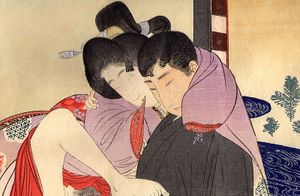Shunga
Shunga (春画) is a Japanese term for erotic art. Most shunga are a type of ukiyo-e, usually executed in Woodcut/woodblock print format. While rare, there are extant erotic painted handscrolls which predate the Ukiyo-e movement. Translated literally, the Japanese word shunga means picture of spring; "spring" is a common euphemism for sex.
The ukiyo-e movement as a whole sought to express an idealization of contemporary urban life. Following the aesthetics of everyday life, Edo period shunga sought to express the sexual mores of the chonin in the widest variety of forms possible, and therefore depicted heterosexual and homosexual, old and young alike, as well as a wide range of fetishes. In the Edo period it was enjoyed by rich and poor, men and women, and despite being out of favor with the shogunate, carried a very little stigma. Almost all ukiyo-e artists made shunga at some point in their careers, and it did not detract from their prestige as artists. Classifying shunga as a kind of medieval pornography can be misleading in this respect.
History
Shunga has its origins in Ancient China. It is thought that shunga was initially inspired by illustrations in Chinese medicine manuals, a process which had its origins in the Muromachi era (1336 to 1573). Zhou Fang ↗, the great Tang Dynasty ↗ Chinese erotic painter, is thought to also have been influential. He, like many erotic artists of his time and place, tended to exaggerate the size of the genital organs, a common shunga topos. While the literal meaning of the word, 'shunga,' is significant, it is in fact a contraction of, 'shunkyu-higi-ga' (春宮秘戯画), the Onyomi (Japanese pronunciation) for Chinese sets of twelve scrolls depicting the twelve sexual acts that the crown prince had to carry out as an expression of yin yang.
In Japan, Shunga goes back to the Heian period. At this point, it was the reserve of the courtier class. Through the medium of narrative handscrolls, sexual scandals from the imperial court or the monasteries were depicted, and the characters tended to be limited to courtiers and monks.
The style reached its apex in the Edo period (1603 to 1867). Thanks to woodblock printing techniques, the quantity and quality increased dramatically. There were repeated governmental attempts to suppress shunga, the first of which was an edict issued by the Tokugawa shogunate in 1661 banning, among other things, erotic books known as k"shokubon (好色本). While other genres covered by the edict, such as works criticizing daimyo or samurai, were driven underground by this edict, Shunga continued to be produced with little difficulty. The 1722 edict was much more strict, banning the production of all new books unless the city commissioner gave permission, and after this edict, Shunga went underground. However, since for several decades following this edict publisher's guilds saw fit to send their members repeated reminders not to sell erotica, it seems probable that production and sale continued to flourish.
The introduction of Western culture and technologies at the beginning of the Meiji era (1868–1912), particularly the importation of photoreproduction techniques, had serious consequences for Shunga. For a time, woodblock printing continued to be used, but figures began to appear in prints wearing Western clothing and hairstyles. Eventually, Shunga could no longer compete with erotic photography, leading to its decline.
The art of shunga provided an inspiration for the Sh"wa and Heisei, or modern, period art known in the Western world as hentai, and known (formally) in Japan as 'jū hachi kin' (literally, "18-restricted", or adult-only) anime and manga. Like shunga, hentai is sexually explicit in its imagery.
Chat rooms • What links here • Copyright info • Contact information • Category:Root
